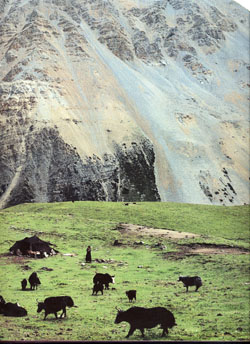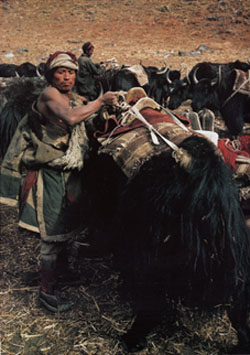Mei-wang Shao
Shady Side Academy, Pittsburgh
Tibet Unit
Home
The Herder's Life
The Caravan
5. TIBETAN SOCIAL STRUCTURE AND PEOPLE'S LIVES:
The structure of Tibetan society can be analysed by social classes- the common people and the nobility. The nobility including the high-born and learned clergy is the wealthy and powerful ruling class while the laborers subordinate to nobility, monastery or State. People's lives are greatly affected by the geographic environment and their Buddhist belief and traditions. Instead of pursuing material goods, they value spiritual merits and next life more. One can see prayer flags and wheels everywhere in Tibet. Everyone there wishes to make at least one pilgrimage to holy sites in their lifetime because they believe one complete pilgrimage can erase the bad deeds of a lifetime.
Because of the limits imposed by the high-altitude environment, the pattern of animal husbandry is mixed with the pattern of cereal agriculture. Life was hard but is improving as time progresses. The book "Tibetan Civilization" written by R.A. Stein is a good teacher's resource. The book " The Struggle for Modern Tibet-The Autobiography of Tashi Tsering" written by Melvyn Goldstein, William Siebenschuh, and Tashi Tsering is also recommended by many scholars for its accuracy and vividness. Tashi Tsering tells us his encounterings under the theocratic feudal government before 1959 and also his life under the Communist rule in 1960's to 1990's. One can learn a lot from his autobiography.
This site was created by M. W.Shao at the NEH Summer Institute "Cultures and Religions of the Himalayan Region," held at the College of the Holy Cross, Summer 2004

